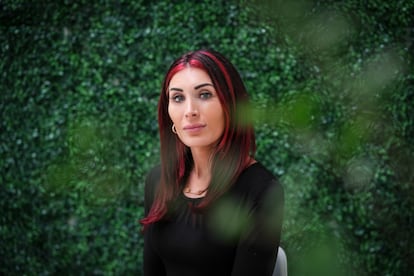The popularity of the ‘Mar-a-Lago face’ soars in Trump’s inner circle
Botox, visible facial fillers and exaggerated tans comprise the aesthetic popular among Donald Trump’s entourage. What’s behind this new fad?

During his first term in office, Donald Trump’s world was characterized by a uniform aesthetic; the women around him all had voluminous hair — the result of the so-called Texan blowout — eyelash extensions, slender silhouettes, a permanent tan and dresses from Chiara Boni La Petite Robe. This clone aesthetic has now gone further for both the men and women in Donald Trump’s orbit to include the so-called ‘Mar-a-Lago face.’
Mar-a-Lago is Trump’s Florida refuge in Palm Beach, a complex he acquired in 1985 and which, according to Joan López Alegre, a communications professor at the Universitat Abat Oliba CEU in Barcelona, is ideal for the U.S. president’s aesthetic. “Donald Trump left New York because there he was seen as a tacky millionaire, while in Florida, his aesthetic makes more sense,” he says. “Yet the decision is not aesthetic, but political. When he moved his residence from Trump Tower to Mar-a-Lago, he abandoned a state with a fixed Democratic majority for one that was then a swing state. Mar-a-Lago is a kind of a summer White House where he has created an alternative with a certain aesthetic.”
The so-called Mar-a-Lago face has undergone exaggerated Botox, visible facial fillers and extreme tanning. Social networks were responsible for this trend going viral by showing the before and after of several women in Donald Trump’s inner circle. Republican National Committee Chairwoman Lara Trump, Kimberly Guilfoyle, Donald Trump’s pick for ambassador to Greece, conspiracy theorist Laura Loomer and South Dakota Governor Kristi Noem all featured in this line-up highlighting the striking differences in their faces over time. “Their faces had all, over an unspecified period, morphed from conventionally human to makeup-caked, angular cheekboned, full-lipped, Fellini-esque exaggerations of the dolled-up Fox News anchorwoman look,” according to Hollywood Reporter journalist Julian Sancton. “And it’s not just the women: Few of us can remember the content of former Florida Rep. (and former prospective attorney general) Matt Gaetz’s RNC speech last summer, so fixated were we on the new elfin arc of his eyebrows. (And the less said about George Santos and his Botox habit the better.)”
Sancton notes that the look is indicative of Trump’s brash departure from the well-established norms of Washington DC and wonders if his return to the White House could be a challenge to the aesthetic discretion that reigned in 2024. “The Trump bubble is a counter-revolutionary movement that bucks the trends of the moment to become the new mainstream. It is a movement based on denying reality,” fashion and celebrity journalist Joan Callarissa tells EL PAÍS. “If they have a face they don’t like, they change it without caring if it looks natural or not, because reality does not matter to Trumpism. Traditionally, the right as a more central force tried not to be so flagrant, but given the current polarization of American society, it was impossible that the change would not also affect aesthetics. Polarization leads us to live in bubbles in which there is a marked tribal factor that means if the leaders have an artificial look, then so will those around them, because [the tribal bubble means] they only see people like themselves.”

It is precisely this need to belong that Amanda Till, a Palm Beach-based tech entrepreneur, speaks of. She told The New York Post she had recently spent between $50,000 and $60,000 on Botox, facial fillers, thread lifts, different laser treatments and the Hydrafacial rejuvenation treatment offered by Dr. Norman Rowe, a plastic surgeon who has opened a new clinic in Florida, close to Mar-a-Lago, which he claims is booming thanks to Donald Trump’s electoral triumph.
“A lot of us who support the president want to look our best,” said Till, who is an increasingly regular visitor to Mar-a-Lago. “It makes you feel like you’re part of something. Everyone here is someone.” And it’s here, too, where everyone has to have a certain aesthetic that sets them apart from the rest of the world.
Trumpist eugenics?
Eugenics is the study and application of the biological laws of heredity aimed at perfecting the human species, and in one of his speeches, Donald Trump accused migrants of “poisoning the blood” of his country, using language reminiscent of Nazi eugenics. What if the Mar-a-Lago face was a kind of Trumpist eugenics in which the aesthetics went far beyond the surface?
Santiago Martinez Magdalena, a professor at the Public University of Navarra, explained in an essay that cosmetic procedures generate a specific, surgical kind of beauty linked to an aesthetic eugenics with “the Caucasian model as a hygienic and normative horizon, the choice of working models and the exposure of the body as the focal point.” He explains to EL PAÍS that its power lies in its ability to show itself, exerting visual influence over what is desirable to see and what is necessary to conceal. “That is, power removes things from the scene and replaces them with others (more worth seeing). Simply because power offers a stage. In this vein, racialization is an indelible stain, or an insolvent wound, that marks you forever and cannot be got rid of. At the same time, old age is a sign of decadence, of a lack of vigor, of illness and of loss of faculties, and therefore a loss of power,” he says.
The paradox lies in the fact that although mass access to cosmetics and cosmetic surgery would allow for a democratic homogenous look leading to a single body type, race, sexuality, and beauty, social class still persists. “They are the ones who write the social grammar, therefore they appear in the script as “the best,” the legitimate ones, the chosen ones, etc. Coupled with a distinguished lifestyle, I don’t find it strange that a Mar-a-Lago face is presented as royalty, with its histrionic court. That is to say, Trump and his kind need to brand themselves, flaunting a class wound. This is provided by surgery,” explains Santiago Martinez Magdalena.

The message of excess
It is striking that precisely when the natural look is triumphing, offered by a series of treatments that are paradoxically highly visible yet hard to pinpoint, the Mar-a-Lago face advocates excess. “The fact that artificial beauty continues to challenge this growing natural trend surely depends on many variables, but let’s not rule out the fact that it is about identity and not only at an individual level, but also at a collective level: a label, like an aesthetic tattoo, that indicates what group you belong to. And let’s not forget the pressure to which we are socially subjected, especially women, due to the passage of time,” says Dr. Natalia Ribé, founder and medical director of the Dr. Natalia Ribé Institute.
Dr. Carlos Gómez, a general surgeon specialized in cosmetic and anti-aging treatments, shares her opinion. “When someone goes for that artificial look, they are often seeking a media “character” that gives people something to talk about and is controversial, and that is exactly what these people are looking for. Otherwise, it is difficult to understand that everyone in the same group – in this case, political – undergoes the same treatment.”
Toni Aira, a professor of political communication at UPF-Barcelona School of Management, flags up the fact that traditionally, in terms of political communication, it has always been recommended that any aesthetic treatment undergone by a high-profile politician should be subtle. “In the end, a politician has to be credible, and credibility is given, among other things, by the perception that the distance between what you are and what you say you are is negligible. Very radical changes in appearance can classically generate distrust towards a person in disguise, who hides, who says they are who they are not,” he explains.
Aira argues that because politics today is highly polarized, radical aesthetic change is not punished. “Now there are politicians that have been voted by a base that is looking for an extreme, something that openly transforms reality in a forceful way, so it [the aesthetic] seems coherent with a philosophy of radical change embraced by the politicians,” he says. “This happens with Trump’s orange makeup. That radicalism, that rupture, is practiced in substance and form through aesthetics as well.”

“In the world of Trumpist conservatism, there’s a lot of dogmatism and scorn directed at science, and in the face of that, there’s obviously going to be more homogenization, because critical thinking is done away with,” says Callarissa. “No one can criticize what the leaders of the movement do, and supporters will imitate it because of the tribal factor. While celebrities nowadays opt for a non-invasive aesthetic medical retouching because they want to look like their real me, Trumpism does the opposite. They operate in the opposite way to how they do it in Hollywood, as if to say: ‘You might want to hide the work you’ve had done but we don’t.”
While Sancton wonders whether we will see a rash of Mar-a-Lago faces among Trump voters, Joan Lopez Alegre makes a final point. “The Trump voter is no longer a conservative voter like the Bush voter, but a lower middle-class voter. It is not clear to me whether they want to be more like Romeo Santos or [Barbie’s] Ken.” But undoubtedly, Trump’s circle is very clear that Barbie and Ken are their references, because ‘more is more’ is their motto.
Sign up for our weekly newsletter to get more English-language news coverage from EL PAÍS USA Edition
Tu suscripción se está usando en otro dispositivo
¿Quieres añadir otro usuario a tu suscripción?
Si continúas leyendo en este dispositivo, no se podrá leer en el otro.
FlechaTu suscripción se está usando en otro dispositivo y solo puedes acceder a EL PAÍS desde un dispositivo a la vez.
Si quieres compartir tu cuenta, cambia tu suscripción a la modalidad Premium, así podrás añadir otro usuario. Cada uno accederá con su propia cuenta de email, lo que os permitirá personalizar vuestra experiencia en EL PAÍS.
¿Tienes una suscripción de empresa? Accede aquí para contratar más cuentas.
En el caso de no saber quién está usando tu cuenta, te recomendamos cambiar tu contraseña aquí.
Si decides continuar compartiendo tu cuenta, este mensaje se mostrará en tu dispositivo y en el de la otra persona que está usando tu cuenta de forma indefinida, afectando a tu experiencia de lectura. Puedes consultar aquí los términos y condiciones de la suscripción digital.
More information
Archived In
Últimas noticias
Chris Martin, Taylor Swift, Elijah Wood and other famous wedding ‘crashers’
‘How does it feel to be a failure?’: Elizabeth Berkley’s journey from ‘Showgirls’ ridicule to vindication
The story of the Málaga virus: The code that haunted Google’s cybersecurity center director for 30 years
The impact of Ecuador’s mega-prison: A polluted river, cleared forests and military checkpoints
Most viewed
- Christian Louboutin: ‘Young people don’t want to be like their parents. And if their parents wear sneakers, they’re going to look for something else’
- The low-cost creative revolution: How technology is making art accessible to everyone
- Liset Menéndez de la Prida, neuroscientist: ‘It’s not normal to constantly seek pleasure; it’s important to be bored, to be calm’
- All the effects of gentrification in one corner of Mexico’s Colonia Roma
- December Social Security and SSI payments: Dates, double checks and the 2026 COLA increase











































